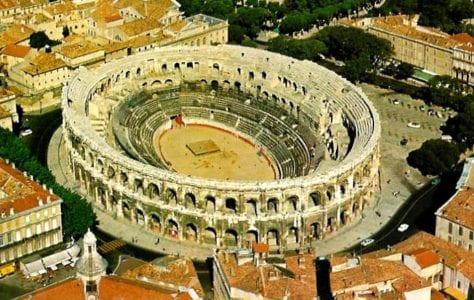 If you visit Nimes, France today, you can experience what it was like for the ancients to attend large-scale events. The Nimes Arena (photo right), a Roman colosseum commissioned by Emperor Augustus in the first century AD, still stands as a testament to the glory and ingenuity of the Empire. It is a stunning example of Rome’s genius for constructing monumental architecture, built on a scale to rival modern arenas with seating for 24,000 people in 34 terraces. One of the best-preserved Roman amphitheaters in the world, the structure has been fully restored and is not only a historic site, but also a modern event venue.
If you visit Nimes, France today, you can experience what it was like for the ancients to attend large-scale events. The Nimes Arena (photo right), a Roman colosseum commissioned by Emperor Augustus in the first century AD, still stands as a testament to the glory and ingenuity of the Empire. It is a stunning example of Rome’s genius for constructing monumental architecture, built on a scale to rival modern arenas with seating for 24,000 people in 34 terraces. One of the best-preserved Roman amphitheaters in the world, the structure has been fully restored and is not only a historic site, but also a modern event venue.
Part of what made Roman architecture so exceptional was the use of concrete to fabricate lasting structures. While the Romans didn’t actually invent concrete, they did perfect it. In 2013, researchers released findings that explained why Roman concrete is so durable. These findings also revealed that the Roman formula for concrete was more sustainable than our modern version, reviving ancient wisdom that is a treasure for the modern world.
Samples were recently taken and studied from a concrete breakwater that had been submerged in the Mediterranean for 2,000 years. Scientists have long marveled that numerous submerged concrete structures in the waters around Italy have survived millennia of saltwater submersion and thrashing by waves and weather, yet remain perfectly intact. Researchers in Europe and the U.S. analyzed the concrete’s mineral components and found that the Romans’ unique formulation of lime and volcanic ash reacted with seawater to bind the mixture and form a virtually indestructible substance.
Humans still love to build with concrete. In fact, it is estimated that the world uses about 19 billion tons of it every year, and it is a primary building component of modern arenas and convention centers. For instance, Concrete Construction reported that more than 1 million square feet of concrete was placed to complete the new T-Mobile Arena in Las Vegas. (A shout out to the folks at T-Mobile Arena. My daughter and I attended the sold out Drake concert there just last week, and despite the crowds, we found the venue beautiful, the staff efficient and friendly, and the overall experience world class.)
The upside for building with concrete is that it is generally considered a sustainable building material due to its strength, durability and thermal mass. And once a concrete structure has reached its lifespan, portions can be disassembled and reused, and the remaining material can be crushed and recycled into aggregate. However, in the mid-20th century, concrete structures were designed to last only 50 years. Now, the target is 100 to 120 years. So how does our version of concrete fall short of that used by the Romans, whose structures have survived the onslaught of time and the elements for more than 2,000 years?
Modern concrete is formulated using Portland cement, which lacks the lime and volcanic ash mixture. It doesn’t bind as well as Roman concrete and has a greater tendency to weaken and crack after a few decades of use. Further, the amount of fuel used to generate the heat necessary to produce Portland cement is a major source of the world’s carbon emissions. The Roman version did not require high heat, making it less polluting to manufacture.
The good news is that ash, called pozzolan, with similar mineral characteristics to that used by the Romans, is found in many parts of the world and is widely accessible for inclusion in modern concrete. Scientists are now experimenting with ways to reformulate modern concrete to mimic that of the ancient world. By understanding and employing the wisdom of Roman engineers, we have an opportunity to build more sustainable structures that will stand for generations.
Green Quote:
“Sustainable development requires human ingenuity. People are the most important resource.” – Dan Shechtman, Winner of the 2011 Nobel Prize in Chemistry





























